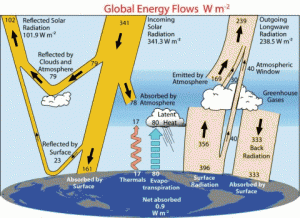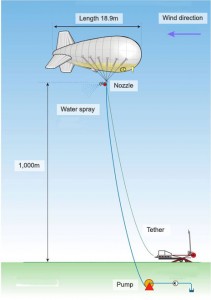SPICE Up Your Life
Scientists from universities across the United Kingdom are hoping to test one of their solutions to the worldwide issue of global warming. To understand the mechanism of the project, however, one must first be familiar with the process of global warming.
Global warming is based on the imbalance of infrared radiation (IR) entering and leaving the planet. This imbalance is caused by gases in the atmosphere, commonly referred to as greenhouse gases, which absorb the IR and emit it back towards the Earth’s surface instead of allowing it to travel back out into space. This process means more energy in the form of heat is being stored in the atmosphere and is consistently increasing Earth’s average temperature each year. Most of the greenhouse gases that are accumulating in the atmosphere are released through aspects of human activity such as farming, transportation, and electricity. Stopping all of these aspects isn’t going to stop the problem, as some of these harmful gases that have already been released will remain in the atmosphere for thousands of years. This gives scientists the opportunity to devise a system to cool the planet.
The SPICE project (Stratospheric Particle Injection for Climate Engineering) aim is to discover the best particle to introduce into the
top of the atmosphere that will decrease the amount of IR entering the atmosphere. Their plan is to inject reflective aerosol particles into the atmosphere in hopes that they reflect the incoming radiation before it can enter the atmosphere. They based this idea on volcanic eruption effects on global temperature. Large eruptions release multiple cubic kilometers of ash and gas that then disperses across the globe creating a layer or reflective particles. Two years following the Mount Pinatubo eruption the global temperature dropped by 0.5 degrees Celsius.
Scientists want to mimic this effect in their tests by spraying reflective particles from a hose at a rate of 100 liters per hour from a 20 m long balloon at a height of 1 km. The balloons success in launch and recovery and its tolerance to high winds will be monitored and help in planning the final result of a colossal balloon at a 20 km altitude. Projections indicate we could lower the global temperature by 2 degrees Celius by spreading 10 – 20 of these balloon mechanisms set at a 20 km altitude around the world.
Demonstrating the SPICE project
I think that though global warming isn’t showing how devastating it can be quite yet but will prove a difficult problem in the near future. The problem scientists are facing is either trying to convince people that global warming is real or that it is an urgent issue we should address. To accomplish this they have to be able to convey their message effectively to their specific audiences. This is where Science 300 concepts apply as we are learning how to use wording, diagrams, and presentation to entice and convince our audience. These skills need to be utilized by scientists to explain the necessity of their research to the public.
Sources:
Note from EOSC 340-Global Climate Change Class
Archer, David. Global warming: understanding the forecast. USA: Blackwell Pub., 2007. Print.
Battison, Leila. “Giant balloon to be launched to test climate fix hope.” BBC News: Science and Environment. BBC, 14 Sept. 2011. Web. 29 Sept. 2011. <www.bbc.co.uk/news/science-environment-14916451 >.
“Global warming – Wikipedia, the free encyclopedia.”Wikipedia, the free encyclopedia. N.p., n.d. Web. 2 Oct. 2011. <http://en.wikipedia.org/wiki/Global_warming>.
“Greenhouse gas – Wikipedia, the free encyclopedia.” Wikipedia, the free encyclopedia. N.p., n.d. Web. 2 Oct. 2011. <http://en.wikipedia.org/wiki/Greenhouse_gas>
“The SPICE project: a geoengineering feasibility study .” NERC. N.p., 14 Sept. 2011. Web. 30 Sept. 2011. <www.nerc.ac.uk/press/releases/2011/22-spice.asp>.




October 2nd, 2011 at 9:52 pm
Very well written. I like your concise explanation for global warming. If scientists can truly achieve this solution to global warming, I won’t feel as guilty driving around my gas guzzling sports-car.
October 5th, 2011 at 9:05 pm
Very interesting concept. I’m just wondering if the particles they are spraying into the atmosphere will lead to adverse effects in the future. It seems to me that all these unnatural chemicals will accumulate over time, and who knows what kind of repercussions there may be.
October 6th, 2011 at 6:29 am
That is actually also a concern of many people living in the UK which is why the project is being slowed down. There are a lot of aggressive sites against this project which make me a little unsure if its just them thinkings it will be bad or they have proof it will be bad. I believe there is a link from the BBC News article I listed at the end if you wanted to read about the effects.
October 15th, 2011 at 9:29 am
Interesting idea, but I remain very skeptical of “techno-fixes” for the problems we’ve created because there is no way to truly test it. Those opposed to the idea may have little proof it will be bad, but do the proponents have enough proof that it won’t be bad? I agree with Cassie: What if it doesn’t work? What happens to all of the stuff they have shot up over time? Scientists need to communicate their work to a variety of audiences, but their message needs to be based on evidence. We’ll have to see how this develops. Thanks for the post!